The Ordovician Arc–Basin System in the Northern Great Xing’an Range (Northeast China): Constraints from Provenance Analysis of the Luohe Formation
Abstract
:1. Introduction
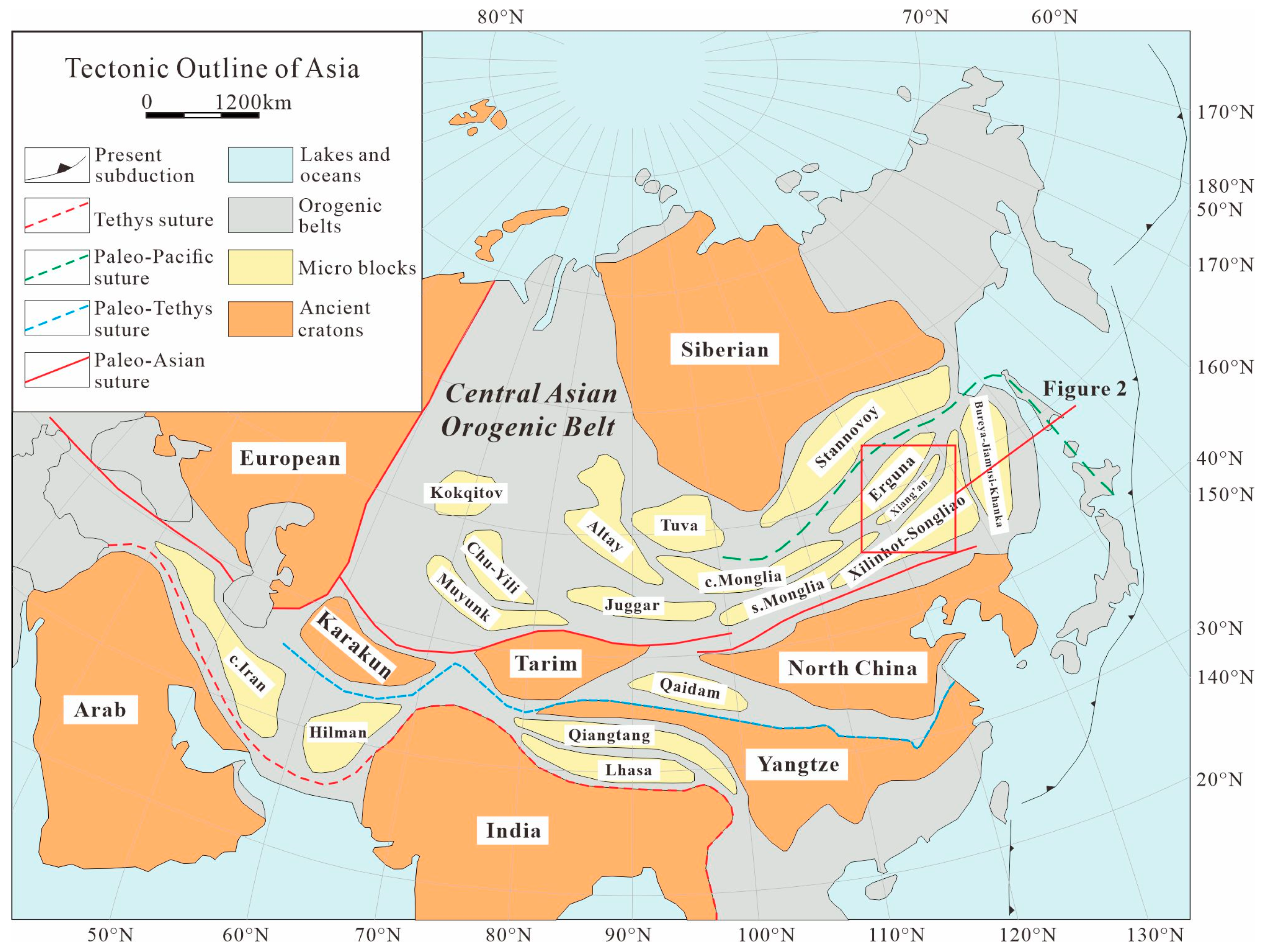
2. Geological Framework
2.1. Regional Geology
2.2. Sampling
3. Analytical Methods
3.1. Detrital Zircon Geochronology
3.2. Sandstone Modal Analyses
3.3. Geochemistry Analyses
3.4. Sedimentary Grain Size Analysis
4. Results
4.1. Zircon U–Pb Geochronology
4.2. Sandstone Modal Analyses
4.3. Geochemistry Analyses
4.3.1. Major Elements
4.3.2. Trace Elements and REE
4.4. Sedimentary Grain-Size Analysis
5. Discussion
5.1. Deposition Age
5.2. Sedimentary Environment
5.3. Provenance
5.3.1. Detrital Zircon Geochronology
5.3.2. Sandstone Modal Analyses
5.3.3. Geochemistry Analyses
5.4. Tectonic Implications
6. Conclusions
- Based on the zircon age data of this study and the age of a monzogranite intrusion, the Luohe Formation was deposited between 457.0 ± 6.5 and 451 ± 6 Ma (i.e., Late Ordovician).
- The detrital zircon age spectra for sandstones of the Luohe Formation show peak ages at 504 and 463 Ma, with subordinate Proterozoic and Neoarchean ages.
- The zircon age distribution for the Luohe Formation rocks is consistent with the timing of periods of magmatism in the Erguna and Xing’an blocks. The youngest peak age of 463 Ma corresponds to the timing of post-collisional magmatism and the formation of the Duobaoshan island arc, and the second peak age of 504 Ma is consistent with magmatism that occurred in association with the collision between the Erguna and Xing’an blocks. The subordinate ages of 783, 826, 973, and 1882 Ma are consistent with magmatism in the Erguna block.
- A new model of the tectonic evolution in the Northern Great Xing’an Range (Northeast China) during the Early Ordovician is proposed. Owing to the subduction of the Paleo-Asian oceanic lithosphere beneath the Erguna–Xing’an Block, an arc–basin system (i.e., the Duobaoshan island arc) was formed in the southern margin of the Erguna–Xing’an Block, and the Luohe Formation was deposited in the corresponding back-arc basin.
Supplementary Materials
Author Contributions
Funding
Data Availability Statement
Acknowledgments
Conflicts of Interest
References
- Jahn, B.M.; Wu, F.Y.; Chen, B. Granitoids of the Central Asian Orogenic Belt and continental growth in the Phanerozoic. Trans. R. Soc. Edinb. 2000, 91, 181–194. [Google Scholar]
- Jahn, B.M.; Wu, F.Y.; Chen, B. Massive granitoid generation in Central Asia: Nd isotope evidence and implication for continental growth in the Phanerozoic. Episodes 2000, 23, 82–92. [Google Scholar] [CrossRef] [PubMed]
- Kröner, A.; Windley, B.F.; Badarch, G. Accretionary growth and crust-formation in the Central Asian Orogenic Belt and comparison with the Arabian–Nubian shield. Geol. Soc. Am. Mem. 2007, 200, 181–209. [Google Scholar]
- Kröner, A.; Kovach, V.; Belousova, E.; Hegner, E.; Armstrong, R.; Dolgopolova, A.; Seltmann, R.; Alexeiev, D.V.; Hoffmann, J.E.; Wong, J. Reassessment of continental growt during the accretionary history of the Central Asian Orogenic Belt. Gondwana Res. 2014, 25, 103–125. [Google Scholar] [CrossRef]
- Safonova, I.Y.; Sennikov, N.V.; Komiya, T. Geochemical diversity in oceanic basalts hosted by the Zasur’ya accretionary complex, NW Russian Altai, Central Asia: Implications from trace elements and Nd isotopes. J. Asian Earth Sci. 2011, 42, 191–207. [Google Scholar] [CrossRef]
- Safonova, I.; Maruyama, S. Asia: A frontier for a future supercontinent Amasia. Int. Geol. Rev. 2014, 56, 1051–1071. [Google Scholar] [CrossRef]
- Yarmolyuk, V.V.; Kovach, V.P.; Kozakov, I.K. Mechanisms of continental crust formation in the Central Asian Foldbelt. Geotectonics 2012, 46, 251–272. [Google Scholar] [CrossRef]
- Xiao, W.J.; Windley, B.F.; Hao, J.; Zhai, M.G. Accretion leading to collision and the Permian Solonker suture, Inner Mongolia, China: Termination of the central Asian orogenic belt. Tectonic 2003, 22, 1069. [Google Scholar] [CrossRef]
- Xiao, W.J.; Santosh, M. The western Central Asian Orogenic Belt: A window to accretionary orogenesis and continental growth. Gondwana Res. 2014, 25, 1429–1444. [Google Scholar] [CrossRef]
- Kovalenko, V.I.; Yarmolyuk, V.V.; Kovach, V.P.; Kotov, A.B.; Kozakov, I.K.; Salnikova, E.B.; Larin, A.M. Isotope provinces, mechanisms of generation and sources of the continental crust in the Central Asian mobile belt: Geological and isotopic evidence. J. Asian Earth Sci. 2004, 23, 605–627. [Google Scholar] [CrossRef]
- Safonova, I.Y.; Santosh, M. Accretionary complexes in the Asia–Pacific region: Tracing archives of ocean plate stratigraphy and tracking mantle plumes. Gondwana Res. 2014, 25, 126–158. [Google Scholar] [CrossRef]
- Dobretsov, N.L.; Berzin, N.A.; Buslov, M.M. Opening and tectonic evolution of the Paleo-Asian Ocean. Int. Geol. Rev. 1995, 37, 335–360. [Google Scholar] [CrossRef]
- Windley, B.F.; Alexeiev, D.; Xiao, W.J.; Kröner, A.; Badarch, G. Tectonic models for accretion of the Central Asian Orogenic Belt. J. Geol. Soc. 2007, 164, 31–47. [Google Scholar] [CrossRef]
- Safonova, I.; Kotlyarov, A.; Krivonogov, S.; Xiao, W.J. Intra-oceanic arcs of the PaleoAsian Ocean. Gondwana Res. 2017, 50, 167–194. [Google Scholar] [CrossRef]
- Safonova, I.Y. Juvenile versus recycled crust in the Central Asian Orogenic Belt: Implications from ocean plate stratigraphy, blueschist belts and intraoceanic arcs. Gondwana Res. 2017, 47, 6–27. [Google Scholar] [CrossRef]
- Li, J.Y. Permian geodynamic setting of Northeast China and adjacent regions: Closure of the Paleo-Asian Ocean and subduction of the Paleo-Pacific Plate. J. Asian Earth Sci. 2006, 26, 207–224. [Google Scholar] [CrossRef]
- Kröner, A.; Lehmann, J.; Schulmann, K.; Demoux, A.; Lexa, O.; Tomurhuu, D.; Stipska, P.; Liu, D.; Wingate, M.T.D. Lithostratigraphic and geochronological constraints on the evolution of the Central Asian Orogenic Belt in SW Mongolia: Early Paleozoic rifting followed by late Paleozoic accretion. Am. J. Sci. 2010, 310, 523–574. [Google Scholar] [CrossRef]
- Zheng, Y.F.; Xiao, W.J.; Zhao, G.C. Introduction to tectonic of China. Gondwana Res. 2013, 23, 1189–1206. [Google Scholar] [CrossRef]
- Xiao, W.; Song, D.; Windley, B.F.; Li, J.; Han, C.; Wan, B.; Zhang, J.; Ao, S.; Zhang, Z. Accretionary processes and metallogenesis of the Central Asian Orogenic Belt: Advances and perspectives. Sci. China Earth Sci. 2020, 63, 329–361. [Google Scholar] [CrossRef]
- Ge, W.C.; Wu, F.Y.; Zhou, C.Y.; Abdel Rahman, A.A. Emplacement age of the Tahe granite and its constraints on the tectonic nature of the Erguna block in the northern part of the Da Xing’an Range. Chin. Sci. Bull. 2005, 50, 2097–2105, (In Chinese with English Abstract). [Google Scholar]
- Miao, L.C.; Fan, W.M.; Zhang, F.Q.; Liu, D.Y.; Jian, P.; Shi, G.H.; Tao, H.; Shi, Y.R. Zircon SHRIMP geochronology of the Xinkailing-Kele complex in the northwestern Lesser Xing’an Range, and its geological implications. Chin. Sci. Bull. 2004, 49, 201–209, (In Chinese with English Abstract). [Google Scholar] [CrossRef]
- Miao, L.C.; Liu, D.Y.; Zhang, F.Q. Zircon SHRIMP U-Pb ages of the “Xinghuadukou Group” in Hanjiayuanzi and Xinlin areas and the “Zhalantun Group” in Inner Mongolia, Da Hinggan Mountains. Chin. Sci. Bull. 2007, 52, 1112–1134, (In Chinese with English Abstract). [Google Scholar] [CrossRef]
- Miao, L.C.; Zhang, F.C.; Jiao, S.J. Age, protoliths and tectonic implications of the Toudaoqiao blueschist Inner Mongolia, China. J. Asian Earth Sci. 2015, 105, 360–373. [Google Scholar] [CrossRef]
- Wu, F.Y.; Sun, D.Y.; Ge, W.C.; Zhang, Y.B.; Grant, M.L.; Wilde, S.A.; Jahn, B.M. Geochronology of the Phanerozoic granitoids in northeastern China. J. Asian Earth Sci. 2011, 41, 1–30. [Google Scholar] [CrossRef]
- Xu, W.L.; Wang, F.; Pei, F.P.; Meng, E.; Tang, J.; Xu, M.J.; Wang, W. Mesozoic tectonic regimes and regional ore-forming background in NE China: Constraints from spatial and temporal variations of Mesozoic volcanic rock associations. Acta Petrol. Sin. 2013, 29, 339–353, (In Chinese with English Abstract). [Google Scholar]
- Liu, Y.J.; Zhang, X.Z.; Jin, W.; Chi, X.G.; Wang, C.W.; Ma, Z.H.; Han, G.Q.; Wen, Q.B.; Li, W.; Wang, W.D.; et al. Late Paleozoic tectonic evolution in Northeast China. Geol. China 2010, 37, 943–951, (In Chinese with English Abstract). [Google Scholar]
- Liu, Y.J.; Li, W.M.; Feng, Z.Q.; Wen, Q.B.; Neubauer, F.; Liang, C.Y. A review of the Paleozoic tectonics in the eastern part of Central Asian Orogenic Belt. Gondwana Res. 2017, 43, 123–148. [Google Scholar] [CrossRef]
- Zhou, J.B.; Wilde, S.A.; Zhang, X.Z.; Zhao, G.C.; Liu, F.L.; Qiao, D.W.; Ren, S.M.; Liu, J.H. A N1300 km late Pan-African metamorphic belt in NE China: New evidence from the Xing’an block and its tectonic implications. Tectonophysics 2011, 509, 280–292. [Google Scholar] [CrossRef]
- Zhou, J.B.; Wilde, S.A.; Zhang, X.Z.; Ren, S.M.; Zheng, C.Q. Early Paleozoic metamorphic rocks of the Erguna block in the Great Xing’an Range, NE China: Evidence for the timing of magmatic and metamorphic events and their tectonic implications. Tectonophysics 2011, 499, 105–117. [Google Scholar] [CrossRef]
- Zhou, J.B.; Wang, B.; Wilde, S.A.; Zhao, G.C.; Cao, J.L.; Zheng, C.Q.; Zeng, W.S. Geochemistry and U-Pb zircon dating of the Toudaoqiao blueschists in the Great Xing’an Range, northeast China, and tectonic implications. J. Asian Earth Sci. 2015, 97, 197–210. [Google Scholar] [CrossRef]
- Zhou, J.B.; Wilde, S.A. The crustal accretion history and tectonic evolution of the NE China segment of the Central Asian Orogenic Belt. Gondwana Res. 2013, 23, 1365–1377. [Google Scholar] [CrossRef]
- Han, G.Q.; Liu, Y.J.; Neubauer, F.; Genser, J.; Li, W.; Zhao, Y.L.; Liang, C.Y. Origin of terranes in the eastern Central Asian Orogenic Belt, NE China: U-Pb ages of detrital zircons from Ordovician-Devonian sandstones, North Great Xing’an Range. Tectonophysics 2011, 511, 109–124. [Google Scholar] [CrossRef]
- Han, G.Q.; Liu, Y.J.; Neubauer, F.; Genser, J.; Zhao, Y.L.; Wen, Q.B.; Li, W.; Wu, L.N.; Jiang, X.Y.; Zhao, L.M. Provenance analysis of Permian sandstones in the central and southern Da Xing’an Mountains, China: Constraints on the evolution of the eastern segment of the Central Asian Orogenic Belt. Tectonophysics 2012, 580, 100–113. [Google Scholar] [CrossRef]
- Han, G.Q.; Liu, Y.J.; Neubauer, F.; Jin, W.; Genser, J.; Ren, S.M.; Li, W.; Wen, Q.B.; Zhao, Y.L.; Liang, C.Y. LA-ICP-MS U-Pb dating and Hf isotopic compositions of detrital zircons from the Permian sandstones in Da Xing’an Mountains, NE China: New evidence for the eastern extension of the Erenhot-Hegenshan suture zone. J. Asian Earth Sci. 2012, 49, 249–271. [Google Scholar] [CrossRef]
- Han, G.Q.; Liu, Y.J.; Neubauer, F.; Bartel, E.; Genser, J.; Feng, Z.Q.; Zhang, L.; Yang, M.C. U-Pb age and Hf isotopic data of detrital zircons from the Devonian and Carboniferous sandstones in Yimin area, NE China: New evidences to the collision timing between the Xing’an and Erguna blocks in eastern segment of Central Asian Orogenic Belt. J. Asian Earth Sci. 2015, 97, 211–228. [Google Scholar] [CrossRef]
- Xu, B.; Zhao, P.; Bao, Q.Z.; Zhou, Y.H.; Wang, Y.Y.; Luo, Z.W. Preliminary study on the pre-Mesozoic tectonic unit division of the Xing-Meng Orogenic Belt (XMOB). Acta Petrologica Sinica 2014, 30, 1841–1857, (In Chinese with English Abstract). [Google Scholar]
- Xu, B.; Zhao, P.; Wang, Y.Y.; Liao, W.; Luo, Z.W.; Bao, Q.Z.; Zhou, Y.H. The pre-Devonian tectonic framework of Xing’an-Mongolia Orogenic belt (XMOB) in north China. J. Asian Earth Sci. 2015, 97, 183–196. [Google Scholar] [CrossRef]
- Feng, Z.Q.; Liu, Y.J.; Liu, B.Q.; Wen, B.Q.; Li, W.M.; Liu, Q. Timing and nature of the Xinlin–Xiguitu Ocean: Constraints from ophiolitic gabbros in the northern Great Xing’an Range, eastern Central Asian Orogenic Belt. Int. J. Earth Sci. 2016, 105, 491–505. [Google Scholar] [CrossRef]
- Wu, G.; Chen, Y.C.; Sun, F.Y.; Liu, J.; Wang, G.R.; Xu, B. Geochronology, geochemistry, and Sr–Nd–Hf isotopes of the early Paleozoic igneous rocks in the Duobaoshan area, NE China, and their geological significance. J. Asian Earth Sci. 2015, 97, 229–250. [Google Scholar] [CrossRef]
- Liu, Y.J.; Feng, Z.Q.; Jiang, L.W.; Jin, W.; Li, W.M.; Guan, Q.B.; Wen, Q.B.; Liang, C.Y. Ophiolite in the eastern Central Asian Orogenic Belt, NE China. Acta Petrol. Sin. 2019, 35, 3017–3047, (In Chinese with English Abstract). [Google Scholar]
- Liu, Y.J.; Li, W.M.; Ma, Y.F.; Feng, Z.Q.; Guan, Q.B.; Li, S.Z.; Chen, Z.X.; Liang, C.Y.; Wen, Q.B. An orocline in the eastern Central Asian Orogenic Belt. Earth-Sci. Rev. 2021, 221, 103808. [Google Scholar] [CrossRef]
- Liu, Y.J.; Ma, Y.F.; Feng, Z.Q.; Li, W.M.; Li, S.Z.; Guan, Q.B.; Chen, Z.X.; Zhou, T.; Fang, Q.A. Paleozoic Orocline in the eastern Central Asian Orogenic Belt. Acta Geol. Sin. 2022, 96, 3468–3493, (In Chinese with English Abstract). [Google Scholar]
- Ma, Y.F.; Liu, Y.J.; Peskov, A.Y.; Wang, Y.; Song, W.M.; Zhang, Y.J.; Qian, C.; Liu, T.J. Paleozoic tectonic evolution of the eastern Central Asian Orogenic Belt in NE China. China Geol. 2022, 5, 555–578. [Google Scholar] [CrossRef]
- Li, J.Y.; Liu, J.F.; Qu, J.F.; Zheng, R.G.; Zhao, S.; Zhang, J.; Wang, L.J.; Zhang, X.W. Paleozoic tectonic units of Northeast China: Continental Blocks or Orogenic Belts? Earth Sci. 2019, 44, 3157–3177, (In Chinese with English Abstract). [Google Scholar]
- Shao, J.A. Crustal Evolution in the Middle Part of the Northern Margin of the Sino-Korean Plate; Peking University Press: Beijing, China, 1991; pp. 1–136, (In Chinese with English Abstract). [Google Scholar]
- Tang, K.D.; Shao, J.A.; Li, Y.F. Songnen massif and its research significance. Earth Sci. Front. 2011, 18, 57–65, (In Chinese with English Abstract). [Google Scholar]
- Tong, Y.; Hong, D.W.; Wang, T.; Shi, X.J.; Zhang, J.J.; Zeng, T. Spatial and temporal distribution of granitoids in the middle segment of the Sino-Mongolian border and its tectonic and metallogenic implications. Acta Geosci. Sin. 2010, 31, 133–150, (In Chinese with English Abstract). [Google Scholar]
- Feng, Z.Q.; Liu, Y.J.; Li, L.; Jin, W.; Jiang, L.W.; Li, W.M.; Zhao, Y.L. Geochemical and geochronological constraints on the tectonic setting of the Xinlin ophiolite, northern Great Xing’an Range, NE China. Lithos 2019, 326, 213–229. [Google Scholar] [CrossRef]
- Zhao, C.; Qin, K.Z.; Song, G.X.; Li, G.M.; Li, Z.Z. Early Palaeozoic high-Mg basalt-andesite suite in the Duobaoshan Porphyry Cu deposit, NE China: Constraints on petrogenesis, mineralization, and tectonic setting. Gondwana Res. 2019, 71, 91–116. [Google Scholar] [CrossRef]
- Chen, A.X.; Zhou, D.; Zhang, Q.K.; Guan, P.Y.; Yang, B. Tectonic and sedimentary environment in the Ordovician period of Central Xing’an Block. Geoscience 2016, 30, 1061–1071, (In Chinese with English Abstract). [Google Scholar]
- Li, L.Y.; Liu, B. Sedimentary geological characteristics and sediment source of Luohe Formation in Wunuer Area, Great Xing’an Range. Mod. Min. 2020, 617, 37–45, (In Chinese with English Abstract). [Google Scholar]
- Zhang, H.H.; Xu, D.B.; Zhang, K. Geochemical characteristic and sedimentary environment of the Devonian Niqiuhe Formation in northern Daxinganling Range. Geol. Resour. 2014, 23, 316–322, (In Chinese with English Abstract). [Google Scholar]
- Zhang, Y.J.; Zhang, C.; Wu, X.W.; Cui, T.R.; Yang, Y.J.; Chen, H.J.; Jiang, B.; Guo, W.; Ma, Y.F. Geochronology and geochemistry of Late Paleozoic marine volcanic from the Zhalantun Area in Northern DaHinggan Mountains and its geological significance. Acta Geol. Sin. 2016, 90, 2706–2720, (In Chinese with English Abstract). [Google Scholar]
- Zhao, Z.; Chi, X.G.; Liu, J.F.; Wang, T.F.; Hu, Z.C. Late Paleozoic arc-related magmatism in Yakeshi region, Inner Mongolia Chronological and geochemical evidence. Acta Petrol. Sin. 2010, 26, 3245–3258, (In Chinese with English Abstract). [Google Scholar]
- Li, L.Y.; Chen, M.; Gong, Q.D.; Zhang, C.H.; Wang, X. Zircon U-Pb age, geochemical characteristics and geological significance of syenogranite in Wunuer area, Great Hinggan Mountains. Geol. Rev. 2019, 65, 389–400, (In Chinese with English Abstract). [Google Scholar]
- Shao, J.D.; Tan, Q.; Wang, H.; Zhang, M.; He, H.Y. The Mesozoic strata and the Jurassic-Cretaceous boundary in the Daxinganling Region. Geol. Resour. 2011, 20, 4–11, (In Chinese with English Abstract). [Google Scholar]
- Zhang, J.H.; Ge, W.C.; Wu, F.Y.; Wilde, S.A.; Yang, J.H.; Liu, X.H. Large-scale Early Cretaceous volcanic events in the northern Great Xing’an Range, northeastern China. Lithos 2008, 102, 138–157. [Google Scholar] [CrossRef]
- Ludwig, K.R. ISOPLOT 3.00: A Geochronological Toolkit for Microsoft Excel; Berkeley Geochronology Center: Berkeley, CA, USA, 2003. [Google Scholar]
- Wiedenbeck, M.; Allé, P.; Corfu, F.; Griffin, W.; Meier, M.; Oberli, F.; Von Quadt, A.; Roddick, J.; Spiegel, W. Three natural zircon standards for U–Th–Pb, Lu–Hf, Trace element and REE analyses. Geostand. Newslett. 1995, 19, 1–23. [Google Scholar] [CrossRef]
- Wiedenbeck, M.; Hanchar, J.; Peck, W.; Sylvester, P. Further characterisation of the 91500 zircon crystal. Geostand. Geoanal. Res. 2004, 28, 9–39. [Google Scholar] [CrossRef]
- Hou, K.J.; Li, Y.H.; Tian, Y.R. In situ U-Pb zircon dating using laser ablation-multi ion counting-ICP-MS. Miner. Depos. 2009, 28, 481–492, (In Chinese with English Abstract). [Google Scholar]
- Dickinson, W.R. Interpreting provenance relations from detrital modes of sandstone. In Provenance of Arenites; Zuffa, G.G., Ed.; Reidel Publishing Co.: Dordrecht, The Netherlands, 1985; pp. 333–361. [Google Scholar]
- Feng, Z.Q.; Liu, Y.J.; Li, W.M.; Zhao, Y.L.; Jiang, L.W. Detrital zircon U-Pb geochronology of the Ordovician sandstone and its constrain to the tectonic evolution of the northern Great Xing’an Range. Acta Petrol. Sin. 2021, 35, 1469–1488. [Google Scholar]
- Jiang, L.W.; Liu, Y.J.; Feng, Z.Q.; Tang, C. Provenance and tectonic environment of Luohe Formation in northern Great Xing’an Range: Evidence from geochemistry and detrital zircon age. Glob. Geol. 2018, 37, 688–701. [Google Scholar]
- Sahu, B.K. Depositional mechanisms from the size analysis of clastic sediment. J. Sediment. Res. 1964, 34, 2–24. [Google Scholar]
- Mccave, I.N.; Syvitiski, J.P.M. Principles and Methods of Geological Particle Size Analysis; Cambridge University Press: New York, NY, USA, 1991; pp. 3–21. [Google Scholar]
- Yang, G.L.; He, Y.L.; Chen, J.L.; Wang, H.F.; Sun, B.N. The stratigraphic age and sedimentary environment of the Luohe Formation in the northeastern part of Inner Mongolia. In Proceedings of the Annual Meeting of Chinese Palaeontological Society, Dongyang, China, 1 November 2013; pp. 46–47, (In Chinese with English Abstract). [Google Scholar]
- Ye, Q.; Yu, Y.; Gao, X.; Liu, S.F. Revision of the Ordovician Luohe Formation in Hanbeibudunzhao area of Altan Hil, Inner Mongolia. Geol. Bull. China 2013, 32, 1548–1557, (In Chinese with English Abstract). [Google Scholar]
- Fedo, C.M.; Sircombe, K.N.; Rainbird, R.H. Detrital zircon analysis of the sedimentary record. Rev. Mineral. Geochem. 2003, 53, 277–303. [Google Scholar] [CrossRef]
- Kalsbeek, F.; Frei, D.; Affaton, P. Constraints on provenance, stratigraphic correlation and structural context of the Volta basin, Ghana, from detrital zircon geochronology: An Amazonian connection? Sediment. Geol. 2008, 212, 86–95. [Google Scholar] [CrossRef]
- Zhang, J.M.; Xu, B.; Yan, L.J.; Wang, Y.Y. Evolution of the Heihe-Nenjiang Ocean in the eastern Paleo-Asian Ocean: Constraints of sedimentological, geochronogical and geochemical investigations from Early-Middle Paleozoic Heihe-Dashizhai Orogenic Belt in the northeast China. Gondwana Res. 2020, 81, 339–461. [Google Scholar] [CrossRef]
- Wu, G.; Sun, F.Y.; Zhao, C.S.; Li, Z.T.; Zhao, A.L.; Pang, Q.B.; Li, G.Y. Discovery ofthe Early Paleozoic post-collisional granites in northern margin of the Erguna massif and its geological significance. Chin. Sci. Bull. 2005, 50, 2733–2743. [Google Scholar] [CrossRef]
- Wu, G.; Chen, Y.; Chen, Y.; Zeng, Q. Zircon U–Pb ages of the metamorphic supracrustal rocks of the Xinghuadukou Group and granitic complexes in the Argun massif of the northern Great Hinggan Range, NE China, and their tectonic implications. J. Asian Earth Sci. 2012, 49, 214–233. [Google Scholar] [CrossRef]
- Sorokin, A.A.; Kotov, A.B.; Sal’nikova, E.B.; Kudryashov, N.M.; Velikoslavinskii, S.D.; Yakovleva, S.Z.; Fedoseenko, A.M.; Plotkina, Y.V. Early Paleozoic Granitoids in the Lesser Khingan Terrane, Central Asian Foldbelt: Age, Geochemistry, and Geodynamic Interpretations. Petrology 2011, 19, 601–617. [Google Scholar] [CrossRef]
- Ren, B.; Sun, L.; Cheng, Y.; Teng, X.; Li, Y.; Hao, S. Zircon U-Pb Ages, Hf isotopic Characteristics of the Yongqinglinchang-Shibazhan Granites in the Northern Da Hinggan Mountains, Northeastern China. Geol. Surv. Res. 2012, 35, 109–117, (In Chinese with English Abstract). [Google Scholar]
- Gou, J.; Sun, D.Y.; Ren, Y.S.; Liu, Y.J.; Zhang, S.Y.; Fu, C.L.; Wang, T.H.; Wu, P.F.; Liu, X.M. Petrogenesis and geodynamic setting of Neoproterozoic and Late Paleozoic magmatism in the Manzhouli Erguna area of Inner Mongolia, China: Geochronological, geochemistry and Hf isotopic evidence. J. Asian Earth Sci. 2013, 67–68, 114–137. [Google Scholar] [CrossRef]
- Tang, J.; Xu, W.L.; Wang, F.; Wang, W.; Xu, M.J.; Zhang, Y.H. Geochronology and geochemistry of Neoproterozoic magmatism in the Erguna Massif, NE China: Petrogenesis and implications for the breakup of the Rodinia supercontineng. Precambrian Res. 2013, 224, 597–611. [Google Scholar] [CrossRef]
- Guo, Y.F.; Yang, Y.C.; Han, S.J.; Tan, Y.; Bo, J.W. Geochemistry and zircon U-Pb dating of the tonalite from Fenghuanshan area in northern Daxing’anling. J. Jilin Univ. (Earth Sci. Ed.) 2016, 46, 1406–1417, (In Chinese with English Abstract). [Google Scholar]
- Yang, H.B.; Liu, Y.; Zheng, J.L.; Liang, Z.K.; Wang, X.Y.; Tang, X.F.; Sun, Y.P. Petrogenesis and geological significance of Neoproterozoic amphibolite and granite in Bowuleshan area, Erguna massif, Northeast China. Geol. Bull. China 2017, 36, 342–356, (In Chinese with English Abstract). [Google Scholar]
- Sun, L.X.; Ren, B.F.; Zhao, F.Q.; Ji, S.P.; Geng, J.Z. Late Paleoproterozoic magmatic records in the Erguna Massif: Evidences from the zircon U-Pb dating of granitic gneisses. Geol. Bull. China 2013, 32, 341–352, (In Chinese with English Abstract). [Google Scholar]
- Hou, W.; Zhao, G.; Han, Y.; Eizenhoefer, P.R.; Zhang, X.; Liu, Q. A ~2.5 Ga magmatic arc in NE China: New geochronological and geochemical evidence from the Xinghuadukou Complex. Geol. J. 2020, 55, 2550–2571. [Google Scholar] [CrossRef]
- Shao, J.; Li, Y.F.; Zhou, Y.H.; Wang, H.B.; Zhang, J. Neo-Archaean magmatic event in Erguna Massif of Northeast China: Evidence from the ziecon LA-ICP-MS dating of the gneissic monzogranite from the drill. J. Jilin Univ. (Earth Sci. Ed.) 2017, 45, 364–373, (In Chinese with English Abstract). [Google Scholar]
- Taylor, S.R.; Mclenman, S.M. The Continental Crust: Its Composition and Evolution; Blackwell Scietific Publicaton: Oxford, UK, 1985; p. 312. [Google Scholar]
- McLennan, S.M.; Hemming, S.; McDaniel, D.K.; Hanson, G.N. Geochemical approaches to sedimentation, provenance and tectonics. In Processes Controlling the Composition of Clastic Sediments; Johnsson, M.J., Basu, A., Eds.; Geological Society of America Special Paper 284; Geological Society of America: Boulder, CO, USA, 1993; pp. 21–40. [Google Scholar]
- McLenna, S.M.; Hemming, S.; Taylor, S.R.; Erikkson, K.A. Early Proterozoic crustal evolution: Geochemical and Nd-Pb isotopic evidence from metasedimentary rocks, southwestern North America. Geochem. Cosmochem. Acta 1995, 59, 1153–1177. [Google Scholar] [CrossRef]
- Bhatia, M.R.; Crook, K.A.W. Trace element characteristics of graywackes and tectonic setting discrimination of sedimentary basins. Contrib. Mineral. Petrol. 1986, 92, 181–193. [Google Scholar] [CrossRef]
- Xiao, X.; Wang, S.H.; Liu, Z.H.; Mai, M.T.; Zeng, Z. Geochemistry characteristics and provenance of the Ordovician Luohe Formation clastic rocks in the northern Great Xing’an Range. West-China Explor. Eng. 2016, 28, 138–142. (In Chinese) [Google Scholar]
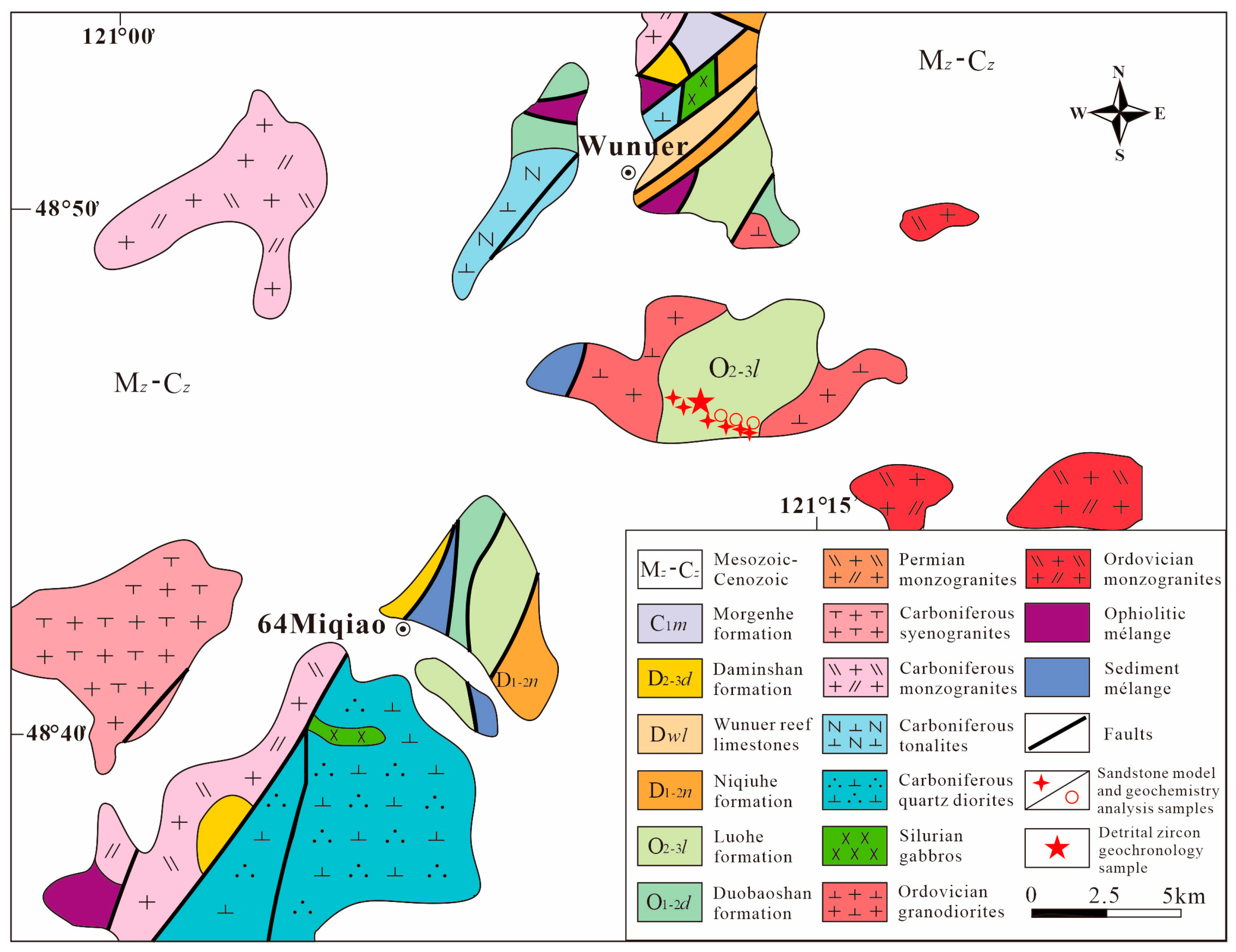
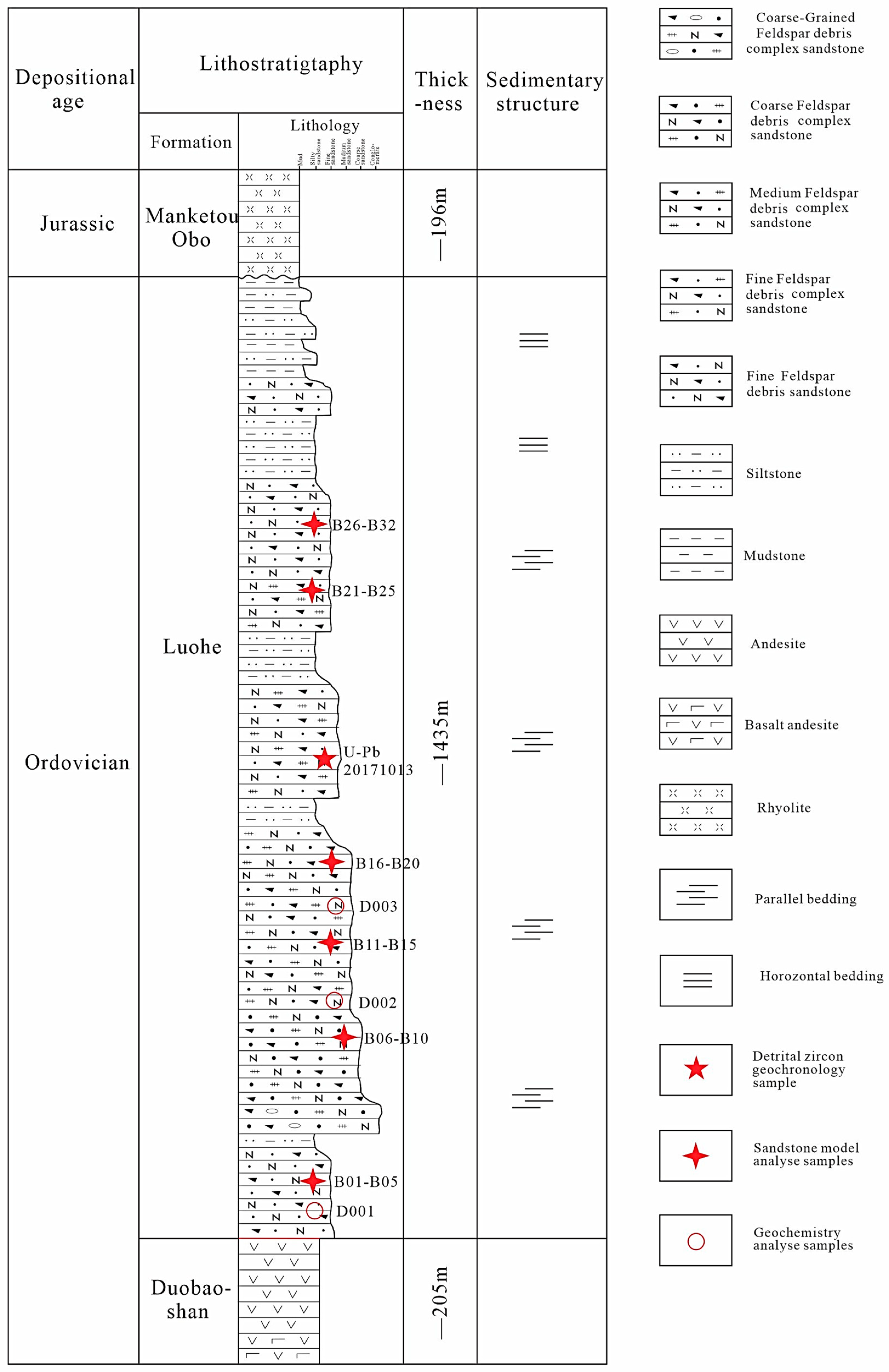
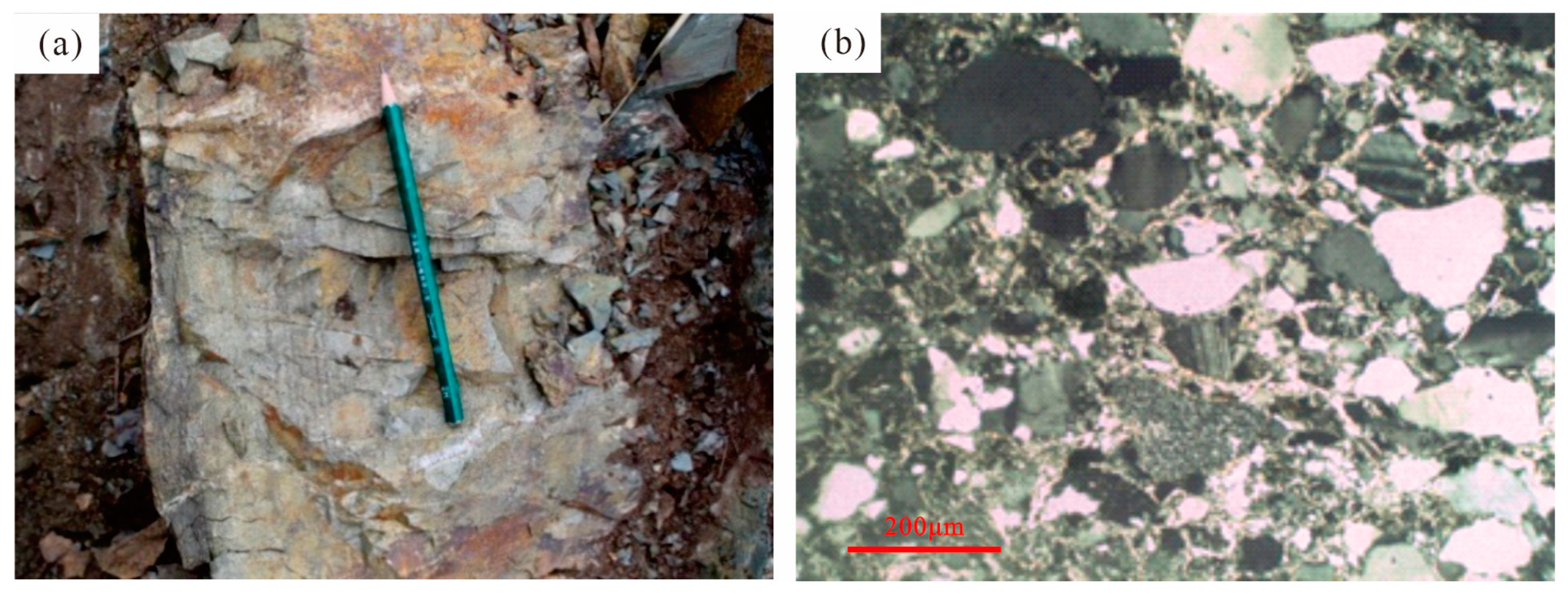


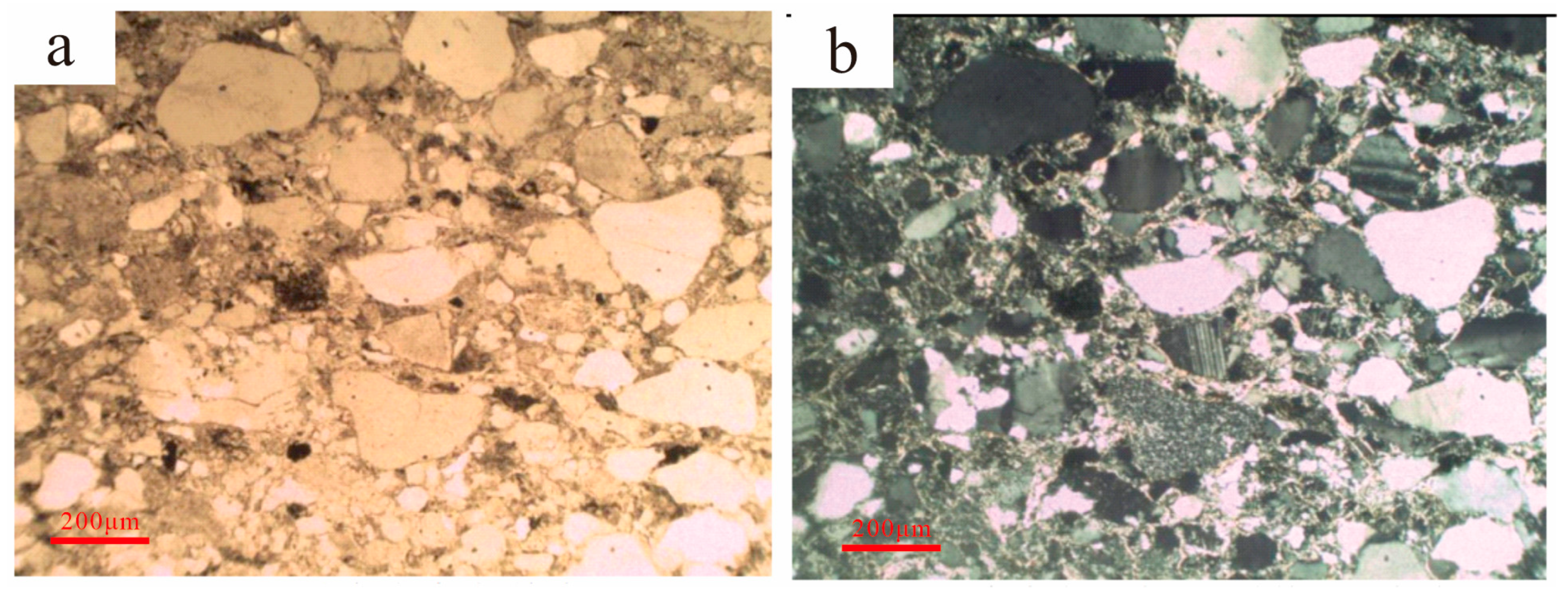
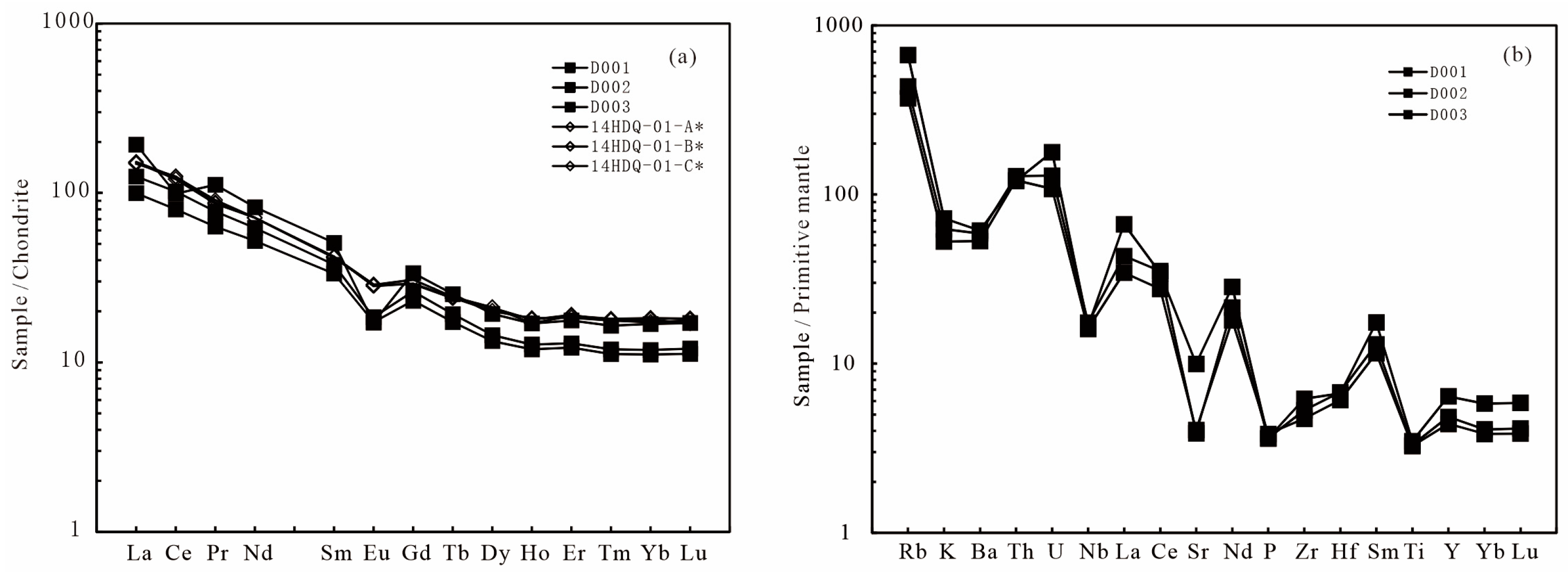



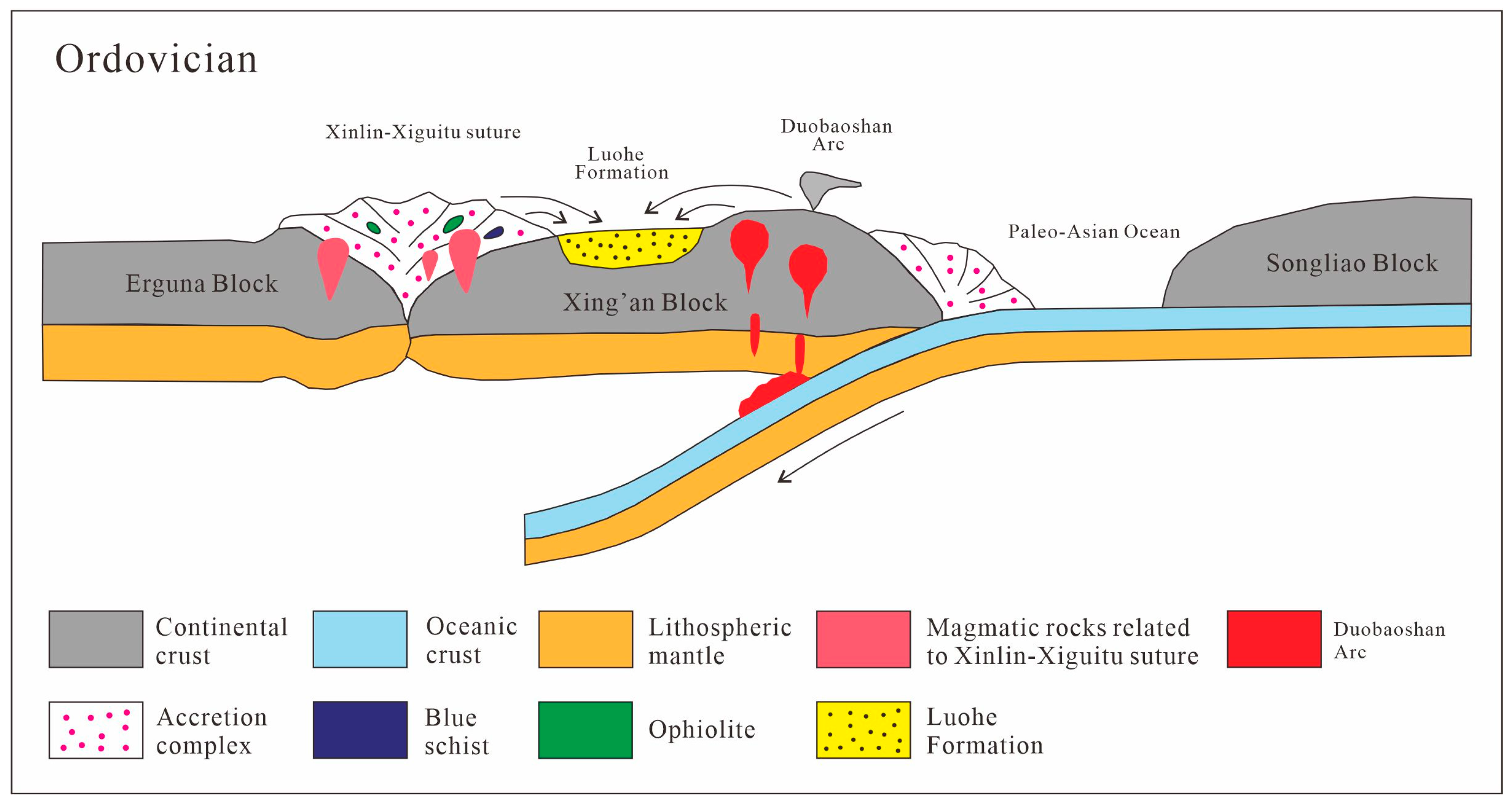
| Sample | Rock | SiO2 | Al2O3 | Fe2O3 | MgO | CaO | Na2O | K2O | MnO | TiO2 | P2O5 | LOI | TOTAL |
|---|---|---|---|---|---|---|---|---|---|---|---|---|---|
| D001 | Feldspar lithic sandstone | 61.25 | 17.19 | 7.48 | 3.87 | 0.43 | 1.53 | 3.77 | 0.12 | 0.74 | 0.16 | 3.43 | 99.97 |
| D002 | Feldspar lithic sandstone | 58.79 | 18.43 | 7.64 | 3.83 | 0.38 | 0.96 | 4.36 | 0.45 | 0.78 | 0.16 | 4.16 | 99.94 |
| D003 | Feldspar lithic sandstone | 60.61 | 17.35 | 7.33 | 4.17 | 0.47 | 1.93 | 3.18 | 0.13 | 0.73 | 0.17 | 3.9 | 99.97 |
| Sample | Rock | Rb | Ba | Th | U | Nb | La | Ce | Sr | Nd | Zr | Hf | Sm |
|---|---|---|---|---|---|---|---|---|---|---|---|---|---|
| D001 | Feldspar lithic sandstone | 276 | 410 | 10.9 | 2.71 | 12.4 | 29.6 | 62.4 | 81.7 | 29 | 59.2 | 2.09 | 5.76 |
| D002 | Feldspar lithic sandstone | 424 | 426 | 10.2 | 3.73 | 11.8 | 45.7 | 60.5 | 210 | 38.4 | 69.3 | 2.06 | 7.75 |
| D003 | Feldspar lithic sandstone | 235 | 370 | 10.3 | 2.26 | 11.4 | 23.6 | 48.9 | 85.3 | 24.3 | 52.8 | 1.88 | 5.1 |
| Sample | Rock | Pr | Eu | Gd | Tb | Dy | Ho | Er | Tm | Y | Yb | Lu | |
| D001 | Feldspar lithic sandstone | 7.37 | 1.07 | 5.38 | 0.72 | 3.67 | 0.721 | 2.14 | 0.304 | 22 | 2.01 | 0.306 | |
| D002 | Feldspar lithic sandstone | 10.6 | 0.995 | 6.9 | 0.944 | 4.9 | 0.959 | 2.92 | 0.419 | 29.1 | 2.86 | 0.433 | |
| D003 | Feldspar lithic sandstone | 6 | 0.999 | 4.74 | 0.646 | 3.39 | 0.675 | 2.02 | 0.285 | 20 | 1.89 | 0.285 |
Disclaimer/Publisher’s Note: The statements, opinions and data contained in all publications are solely those of the individual author(s) and contributor(s) and not of MDPI and/or the editor(s). MDPI and/or the editor(s) disclaim responsibility for any injury to people or property resulting from any ideas, methods, instructions or products referred to in the content. |
© 2024 by the authors. Licensee MDPI, Basel, Switzerland. This article is an open access article distributed under the terms and conditions of the Creative Commons Attribution (CC BY) license (https://creativecommons.org/licenses/by/4.0/).
Share and Cite
Li, L.; Zhang, C.; Feng, Z. The Ordovician Arc–Basin System in the Northern Great Xing’an Range (Northeast China): Constraints from Provenance Analysis of the Luohe Formation. Minerals 2024, 14, 258. https://doi.org/10.3390/min14030258
Li L, Zhang C, Feng Z. The Ordovician Arc–Basin System in the Northern Great Xing’an Range (Northeast China): Constraints from Provenance Analysis of the Luohe Formation. Minerals. 2024; 14(3):258. https://doi.org/10.3390/min14030258
Chicago/Turabian StyleLi, Liyang, Chuanheng Zhang, and Zhiqiang Feng. 2024. "The Ordovician Arc–Basin System in the Northern Great Xing’an Range (Northeast China): Constraints from Provenance Analysis of the Luohe Formation" Minerals 14, no. 3: 258. https://doi.org/10.3390/min14030258
APA StyleLi, L., Zhang, C., & Feng, Z. (2024). The Ordovician Arc–Basin System in the Northern Great Xing’an Range (Northeast China): Constraints from Provenance Analysis of the Luohe Formation. Minerals, 14(3), 258. https://doi.org/10.3390/min14030258






